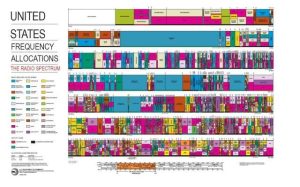Apakah maksud pertempuran spektrum AI untuk 5G?

Hari ini, kebanyakan pembaca mungkin sudah memahami kepentingan spektrum kepada 5G, dan cara spektrum diperoleh adalah agak mudah, sama ada lelongan lelong atau lesen pengedaran nasional. Pada masa kini, persaingan "grab land" sumber spektrum di pelbagai negara telah pun berakhir, dan pengusaha berdepan dengan kos pembinaan yang tinggi. Tugas yang paling mendesak ialah bagaimana untuk meningkatkan penggunaan spektrum.

Antaranya, perkongsian spektrum dianggap sebagai cara utama untuk menamatkan kekurangan spektrum. Tetapi dalam proses masa, terdapat banyak masalah yang tidak boleh diabaikan. Dan bagaimana AI akan mempengaruhi jejak 5G menjadi realiti?
Mana susahnya perkongsian spektrum?
Secara ringkasnya, pelbagai jenis rangkaian boleh mengeluarkan beberapa sumber spektrum mengikut keadaan perniagaan mereka sendiri dan menggunakannya bersama rangkaian lain. Sebagai contoh, pada awal 5G, jika anda ingin membahagikan sebahagian daripada spektrum 4G asal kepada 5G, ia secara langsung akan mengurangkan spektrum 4G yang tersedia, dan tidak terdapat begitu banyak terminal 5G. Kebarangkalian besar untuk memperuntukkan spektrum masa lalu juga adalah satu pembaziran.
Sebenarnya, seawal 2017, 3GPP mempercepatkan standard 5G, dan juga memperkenalkan penyelidikan perkongsian spektrum 5G NR, yang termasuk perkongsian spektrum sebagai sebahagian daripada standard 5G. Tetapi hari ini, perkongsian spektrum tidak dipromosikan secara meluas.

Yang pertama ialah cabaran teknikal. Perkongsian spektrum bermakna dua rangkaian komunikasi wayarles berkongsi jalur frekuensi yang sama, tetapi masalah keserasian antara saluran mudah berlaku.
Sebagai contoh, 4G ialah sistem jalur lebar, konfigurasi saluran adalah agak luas, dan 5G juga merupakan sistem jalur lebar. Terdapat juga pelbagai saluran fizikal. Untuk mengelakkan gangguan antara saluran fizikal antara kedua-dua sistem, adalah perlu untuk mencadangkan dengan sangat tepat “peraturan lalu lintas” untuk mengelak “ranap.”
Pada masa yang sama, semakin banyak piawaian rangkaian yang wujud bersama telah meningkatkan lagi kesukaran untuk berkongsi. Sebagai tambahan kepada 2G/3G/4G/5G sedia ada, dan lain-lain., Internet satelit dan sistem ketenteraan juga berkembang.
Seawal 2015, Suruhanjaya Komunikasi Persekutuan (FCC) mengeluarkan jalur CBRS dengan lebar jalur 150MHz, membenarkan pengguna lain menggunakannya untuk mengurangkan tekanan sumber spektrum yang terhad dan meningkatkan kesesakan. Namun begitu, kemerosotan rangkaian seperti 2G/3G bukanlah sesuatu yang boleh dilakukan dalam sekelip mata. Dalam tempoh ini, bagaimana untuk menyelaraskan pembinaan 5G dengan penawaran dan permintaan spektrum telah menjadi syarat yang perlu bagi pengendali untuk terus hidup.
Selepas 5G telah menyelesaikan satu siri persediaan asas, sudah tiba masanya untuk sampai ke lapisan tengah rantaian industri, dan benar-benar berfikir tentang cara meningkatkan kecekapan operasi, dan kemudian mencapai insurans berganda untuk pengalaman pengguna dan faedah perniagaan.Pada pandangan kami, algoritma AI yang komprehensif boleh menjadi kewujudan yang paling kritikal untuk menyokong rangkaian 5G dan dunia sebenar. Sekurang-kurangnya dalam perkongsian spektrum, AI boleh memainkan tiga peranan utama:

Yang kedua ialah penjadualan pintar. Situasi kewujudan bersama pelbagai sistem juga menjadikan perubahan puncak tempat liputan trafik rangkaian lebih sukar untuk diramalkan. Algoritma pintar boleh melaraskan semula kapasiti sistem antara 4G dan 5G mengikut permintaan trafik sebenar supaya penyelesaian 5G rangkaian hibrid dapat diselesaikan. Semua peralatan dalam penyelesaian boleh mengekalkan prestasi optimum dari semasa ke semasa.
Sebagai contoh, Penyelesaian CloudAIR Huawei, Perisian perkongsian spektrum Ericsson, menggunakan algoritma penjadualan pintar untuk mencapai kebolehlaksanaan 4G dan 5G berjalan serentak dan atas permintaan pada frekuensi pembawa yang sama.

Yang ketiga ialah penggunaan yang cekap. Persaingan terakhir pengendali 5G masih dalam inovasi perniagaan. Namun begitu, keperluan pelbagai jenis perkhidmatan untuk penunjuk rangkaian berbeza-beza secara meluas. Akses beransur-ansur IoT besar-besaran juga meletakkan keperluan yang lebih tinggi pada kapasiti tampung pengendali. Untuk menyokong keperluan perniagaan yang pelbagai dan pembangunan aplikasi yang pesat, dan untuk mendapatkan pulangan pendapatan pelaburan daripada pengguna secepat mungkin, adalah penting untuk membantu pengguna mendapatkan pengalaman terbaik 5G dengan mengeluarkan aplikasi dengan cepat dengan keupayaan penggunaan AI yang cekap.
Semuanya, dalam pertempuran untuk spektrum 5G ini, penggunaan AI untuk mencapai pengurusan yang diperhalusi, cadangan ini sedang menunggu reka bentuk teratas, pengendali, pembekal infrastruktur, pemaju dan pengamal lain untuk bekerjasama untuk membina.
Bukan mudah untuk melakukan operasi yang lebih baik pada sistem komunikasi yang membawa berbilion-bilion netizen. Namun begitu, masalah juga bermakna peluang.Siapa yang boleh memimpin dalam permainan tangkapan teknologi perkongsian spektrum ini, adalah jelas bahawa kumpulan pertama lombong emas revolusi 5G akan digali oleh peranan "tukang air".Pada masa ini, nampaknya peluang-peluang itu lebih cenderung untuk muncul dalam bidang tersebut, satu ialah infrastruktur rangkaian awan.
Oleh kerana keperluan perkhidmatan pengendali yang berbeza tidak konsisten dalam masa, angkasa lepas, dan kekerapan, adalah perlu untuk mewujudkan antara muka yang dikongsi antara berbilang pengendali’ spektrum untuk bertukar maklumat dan merundingkan peraturan perkongsian spektrum, tetapi beroperasi dalam hubungan kompetitif. Antara peniaga tidak akan bersedia untuk berinteraksi dengan maklumat sensitif yang lebih terperinci, kemudian bagaimana untuk mengawal sumber spektrum berdasarkan maklumat kabur? Hari ini kita tahu bahawa banyak fungsi AI telah disepadukan ke dalam awan, dan awan dalam talian teras boleh mencapai penyepaduan pelbagai dimensi pengendali’ sumber antara muka udara, yang menjadi trend zaman.

Yang lain ialah Internet Perkara yang umum merentas terminal.
Seperti yang kita tahu, dalam transformasi pintar Internet industri dan rangkaian kereta, adalah perlu untuk mewujudkan sambungan yang stabil antara sistem berbilang rangkaian dan berbilang terminal. Ia boleh dikatakan bahawa ia adalah pos luar aplikasi 5G dan bidang percubaan perkongsian spektrum. Pada masa ini, dasar itu telah pun merancang untuk memperuntukkan beberapa jalur frekuensi baharu bagi menyokong pembangunannya. Pada masa yang sama, di bawah premis untuk memastikan tiada gangguan radio, ketiga-tiga pengendali itu juga menggunakan rangkaian sedia ada untuk menjalankan NB-IoT (Internet Perkara jalur sempit) ujian. Perkongsian frekuensi sistem jalur lebar masa depan dan kaedah pengurusan mungkin yang pertama dilahirkan dalam bidang ini, dan industri itu sendiri berpeluang merasai kemanisan 5G terlebih dahulu.
Pertempuran untuk spektrum juga mungkin berlanjutan kepada pembinaan 6G yang lebih jauh. Walaupun perkongsian spektrum benar-benar menjadi kenyataan daripada pelan tindakan teknikal, sokongan industri AI amat diperlukan. Dan kami juga berada dalam trajektori peningkatan pintar bandar selangkah demi selangkah, dan secara beransur-ansur melihat arah.



